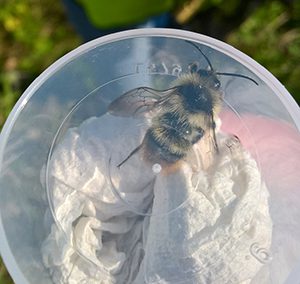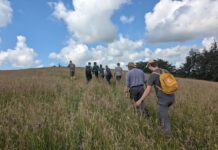
A conservation project at Thames Water’s Long Reach sewage works in Kent has created an unexpected haven for the rarest bumblebee in England.
Shrill carder bees (Bombus sylvarum) have made an unlikely home in the grounds of the sewage treatment works and their local population at the site has been seemingly boosted after an extensive effort by Thames Water and the Bumblebee Conservation Trust.
In 2017, the company partnered with the Trust on its “Making a Buzz for the Coast” project, which aims to safeguard rare bee populations through the creation and restoration of habitats and by linking isolated populations together by developing flower-rich ‘stepping stones’.
The project has shown positive results with more bumblebees now making the sewage works their home. Only one Shrill carder bee was recorded by the Bumblebee Conservation Trust during surveys in summer 2018, while 27 Shrill carders were recorded in August 2019 after major planting and site management changes took place. A survey on 5 August 2020 found seven brown banded carder bumblebees (Bombus humilis), another rare bumblebee species.
Thames Water is the only business to be involved in the three-year project as a project partner, with the other partners being charities and local authorities.
To create a home fit for rare bees the company designated 2.5 hectares of the sewage works to grow tussocky grassland and wildflowers, which are ideal habitats for bees and other pollinators. It also created foraging habitat by planting a lavender hedge and, this year, there are plans to provide bee-friendly trees.
Karen Sutton, Thames Water nature reserve manager, said: “This project has not only helped the bees at Long Reach but improved where our colleagues work. They can take real pride in knowing they have made a difference for these rare bees and can enjoy the benefits of the grassland and wildflowers they help to look after.”
Eight sewage technicians and other site staff who are responsible for maintaining the site, have been closely involved in habitat maintenance and regularly attending volunteer surveys to count the numbers of bees at the facility.
At the start of the project, members of the Bumblebee Conservation Trust gave an education workshop so Thames Water staff could easily identity and track the growing population.
The Trust found the distribution of the bees at the sewage works had also changed due to the conservation efforts by Thames Water’s employees. Historical records have shown the Shrill carder bee in only one small area at Long Reach but in 2019 sightings were recorded across the site.
Graham Hills, site manager at Long Reach sewage works, which serves 862,000 Thames Water customers, said: “You wouldn’t expect rare bees at a sewage works but that’s what we now have in abundance at Long Reach. Our site team have been involved from the start, planting flowers and bushes and it’s been great to see the fruits of their efforts. I’d like to thank them for volunteering their spare time and helping make this project a success.”
Kate Fidczuk-Sterry, conservation officer for the Making a Buzz for the Coast project, said: “It’s incredibly exciting and rewarding to see bumblebees, in particular the rare bumblebees we have been focusing on, feeding on the new areas of forage created.
“Areas of grassland previously cut regularly throughout the summer season have been left uncut and it has been fascinating to see the variety of wildflowers that have popped up and the pollinators that have been enjoying them. Long Reach and Thames Water are a great example how wildlife can be encouraged within an active site as well as making sure safety and asset management is not compromised.
“One of the highlights of my role has been working with the Long Reach staff. It has been a joy to see their enthusiasm and knowledge grow in regards to bumblebees and I have loved seeing their passion for the wildlife already on site.”
Emma Lansdell, project manager for Making a Buzz for the Coast, added: “Thames Water are an active and committed project partner for Making a Buzz for the Coast. We are very excited by the results that have been achieved in just two years at Long Reach STW for biodiversity management of this important site and the conservation of the rare shrill carder bee.”
The Making a Buzz for the Coast project spans 135 miles of Kent coastline from Dartford, where Long Reach sewage works is based, to Deal.
From 2020 to 2025, Thames Water has committed to enhance biodiversity by 5% at 253 of its sites which have biodiversity interest.
Thames Water has more than 100 sites open to the community – including Walthamstow Wetlands – runs five nature reserves and two recreational fisheries as well as supporting a further 22 in partnership with environmental groups such as Wildlife Trusts.
More information the Bumblebee Conservation Trust and Making a Buzz for the Coast Project: https://www.bumblebeeconservation.org/making-a-buzz-for-the-coast/
More information about Thames Water’s nature reserves: https://www.thameswater.co.uk/about-us/responsibility/days-out








